Hydrangeas are a popular flowering shrub known for their large, showy blooms that come in a variety of colors. However, if you notice your hydrangea leaves turning yellow, it can be a cause for concern. Yellowing leaves can be a sign of a nutrient deficiency, improper watering, or environmental stressors. In this article, I will explore the common causes of hydrangea leaf yellowing and provide tips on how to fix the issue.
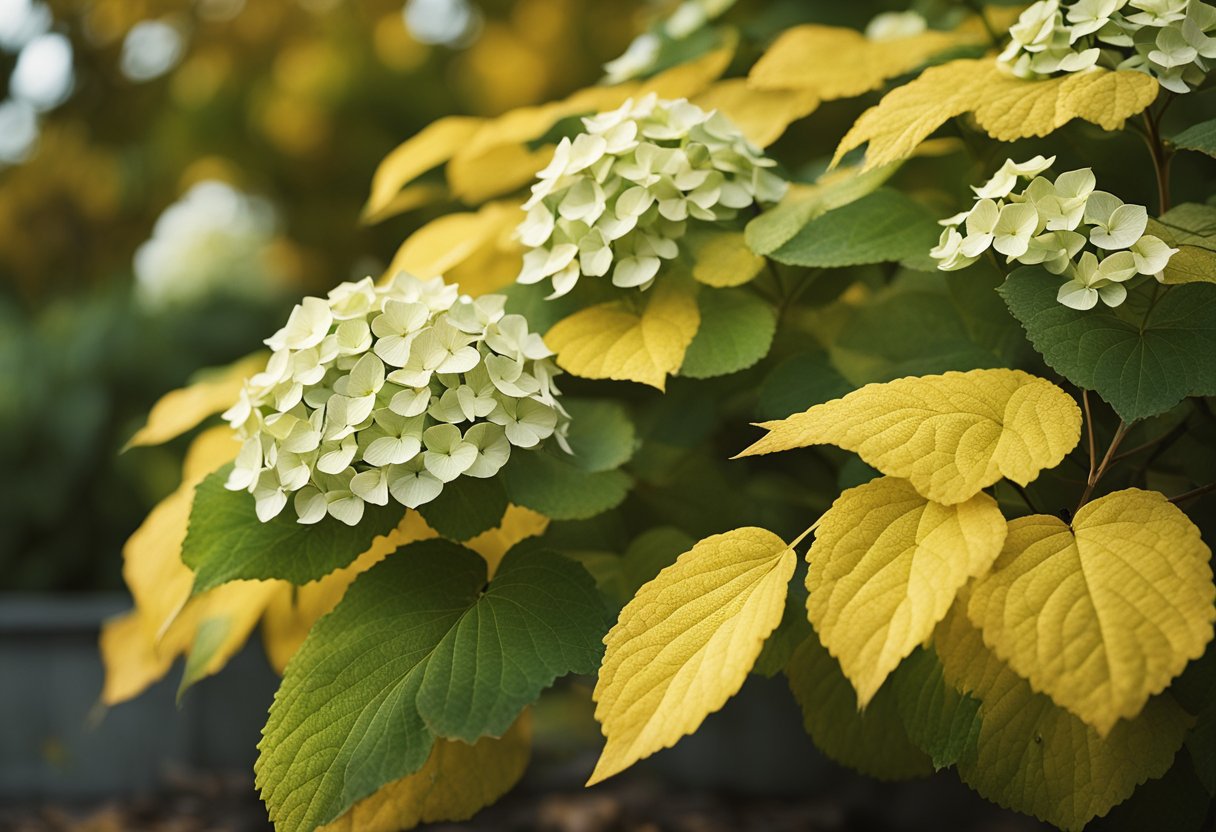
Understanding Hydrangea Leaf Yellowing is essential to maintaining a healthy plant. Nutrient deficiencies and soil quality, watering practices, and environmental stressors can all contribute to yellowing leaves. Proper hydrangea maintenance, including choosing the right varieties for your climate and fertilization, can also help prevent yellowing. Additionally, seasonal care and winterization can ensure your hydrangeas stay healthy year-round. In this article, I will provide a comprehensive guide to help you revive yellowing hydrangeas and keep them looking their best.
Key Takeaways
- Hydrangea leaf yellowing can be caused by nutrient deficiencies, improper watering, or environmental stressors.
- Proper hydrangea maintenance, such as choosing the right varieties and fertilization, can help prevent yellowing.
- Seasonal care and winterization are essential for keeping hydrangeas healthy year-round.
Understanding Hydrangea Leaf Yellowing
Hydrangeas are popular ornamental plants known for their large, showy blooms and lush foliage. However, one common problem that many gardeners face is yellowing leaves on their hydrangea plants. In this section, I will discuss some of the causes of yellowing leaves in hydrangeas and how photosynthesis and chlorophyll play a role in this process.
Causes of Yellow Leaves
There are several reasons why hydrangea leaves may turn yellow, including:
- Nutrient deficiencies: Hydrangeas require a balanced supply of nutrients to grow and thrive. If the soil is lacking in essential nutrients such as nitrogen, iron, or magnesium, the leaves may turn yellow.
- Overwatering or underwatering: Hydrangeas prefer moist, well-drained soil. If the soil is too wet or too dry, the leaves may turn yellow.
- Exposure to extreme temperatures: Hydrangeas are sensitive to both hot and cold temperatures. If the plant is exposed to extreme temperatures, the leaves may turn yellow.
- Pest infestations: Some pests, such as spider mites or aphids, can cause yellowing leaves on hydrangeas.
Photosynthesis and Chlorophyll
Photosynthesis is the process by which plants convert sunlight into energy. Chlorophyll, a green pigment found in plant cells, plays a crucial role in this process by capturing light energy and converting it into chemical energy. When chlorophyll is in short supply, the leaves may turn yellow.
In hydrangeas, yellowing leaves may be a sign of chlorosis, a condition in which the plant is unable to produce enough chlorophyll. Chlorosis can be caused by a variety of factors, including nutrient deficiencies, pH imbalances, and poor soil drainage.
To prevent yellowing leaves in hydrangeas, it is important to provide the plant with the right growing conditions. This includes regular watering, fertilization, and proper soil drainage. By understanding the causes of yellowing leaves and how photosynthesis and chlorophyll play a role in this process, gardeners can take steps to keep their hydrangeas healthy and vibrant.
Nutrient Deficiencies and Soil Quality
Hydrangeas require specific nutrients to grow and produce vibrant foliage. Nutrient deficiencies can cause the leaves to turn yellow. Soil quality also plays a significant role in the growth and health of hydrangeas.
Iron Deficiency
Iron is a crucial element for the development of the leaves and stems of the plant. If there is not enough iron in the soil, chlorophyll production during photosynthesis will be disturbed, and the plant will develop a disease called chlorosis, causing the leaves to turn yellow.
To fix iron deficiency, you can add chelated iron to the soil or spray the leaves with a foliar spray containing iron. Be careful not to overdo it, as too much iron can be toxic to the plant.
Nitrogen Deficiency
Nitrogen is essential for the growth and development of hydrangeas. A lack of nitrogen in the soil can cause the leaves to turn yellow and stunt the growth of the plant.
To fix nitrogen deficiency, you can add nitrogen-rich fertilizer to the soil. However, be careful not to over-fertilize, as this can lead to other problems like root burn and decreased flower production.
Soil pH and Nutrient Uptake
Soil pH also plays a significant role in the growth and health of hydrangeas. Hydrangeas prefer slightly acidic soil with a pH between 5.2 and 6.2. If the soil pH is too high or too low, the plant may not be able to absorb certain nutrients, causing the leaves to turn yellow.
To fix soil pH, you can add soil amendments like sulfur or lime to adjust the pH level. It is essential to test the soil regularly to ensure that the pH level is within the optimal range for hydrangeas.
Nutrient deficiencies and soil quality are significant factors that can cause hydrangea leaves to turn yellow. It is essential to provide the plant with the necessary nutrients and maintain optimal soil pH to ensure healthy growth and vibrant foliage.
Also Read | Bell Pepper Plant Growth Stages | Life Cycle Explained
Watering Practices
As a hydrangea owner, I know that watering practices can significantly affect the health of the plant. In this section, I will discuss the two most common watering issues that can cause hydrangea leaves to turn yellow: overwatering and underwatering.
Overwatering
Overwatering is a common mistake that many plant owners make. It can lead to waterlogged soil, which can cause root rot and other issues. When a hydrangea is overwatered, its leaves may turn yellow and wilt. In severe cases, the plant may die.
To avoid overwatering, I recommend checking the soil moisture level regularly. Hydrangeas prefer moist soil, but not wet soil. If the soil is still moist, wait a few more days before watering. If the soil is dry, water the plant deeply.
Underwatering
On the other hand, underwatering can also cause hydrangea leaves to turn yellow. When a hydrangea is not watered enough, the soil can become too dry, and the plant may not receive enough nutrients. The leaves may turn yellow and become crispy.
To prevent underwatering, I suggest checking the soil moisture level regularly. If the soil is dry, water the plant deeply. Hydrangeas need at least one inch of water per week. However, be careful not to overwater the plant.
By following these watering practices, you can help your hydrangea stay healthy and prevent its leaves from turning yellow.
Environmental Stressors
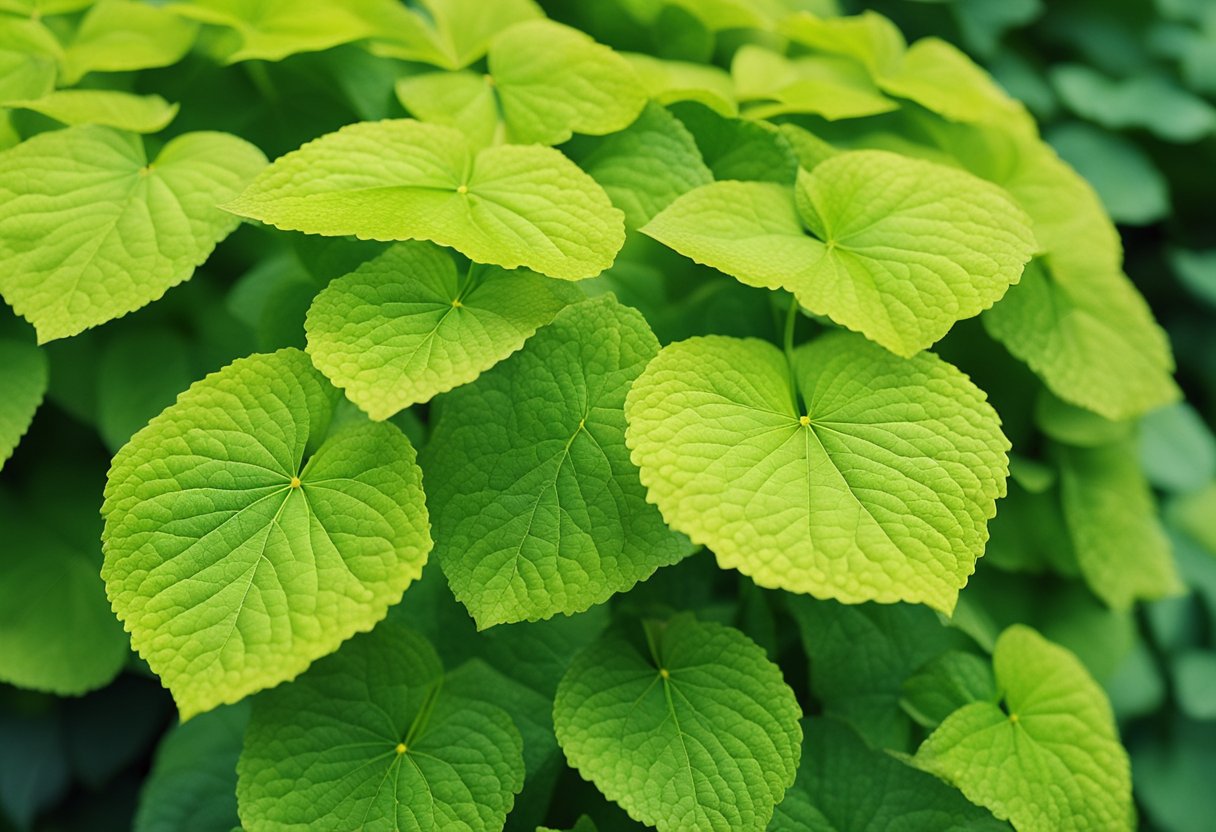
Hydrangeas are sensitive plants that can be affected by various environmental stressors. In this section, I will discuss two significant stressors that can cause hydrangea leaves to turn yellow: sunlight exposure and temperature extremes.
Sunlight Exposure
Hydrangeas require a moderate amount of sunlight to grow and thrive. However, excessive exposure to direct sunlight can cause the leaves to turn yellow. This is because the intense heat from the sun can damage the plant’s delicate tissues, leading to leaf discoloration.
To prevent this, it is essential to provide your hydrangeas with adequate shade during the hottest part of the day. You can achieve this by planting them in an area that receives partial shade or by using shade cloth to cover them during the peak hours of sunlight.
Temperature Extremes
Hydrangeas are also sensitive to extreme temperatures. Exposure to cold or hot temperatures can cause the leaves to turn yellow and fall off. This is because extreme temperatures can cause the plant’s cells to rupture, leading to damage and discoloration.
To prevent this, it is essential to plant your hydrangeas in an area with a moderate climate. If you live in an area with extreme temperatures, you may need to provide your plants with additional protection. You can do this by using frost blankets to protect them from cold temperatures or by using shade cloth to protect them from excessive heat.
By understanding and addressing these environmental stressors, you can help prevent your hydrangea leaves from turning yellow and ensure that your plants remain healthy and vibrant.
Pest Infestation and Disease
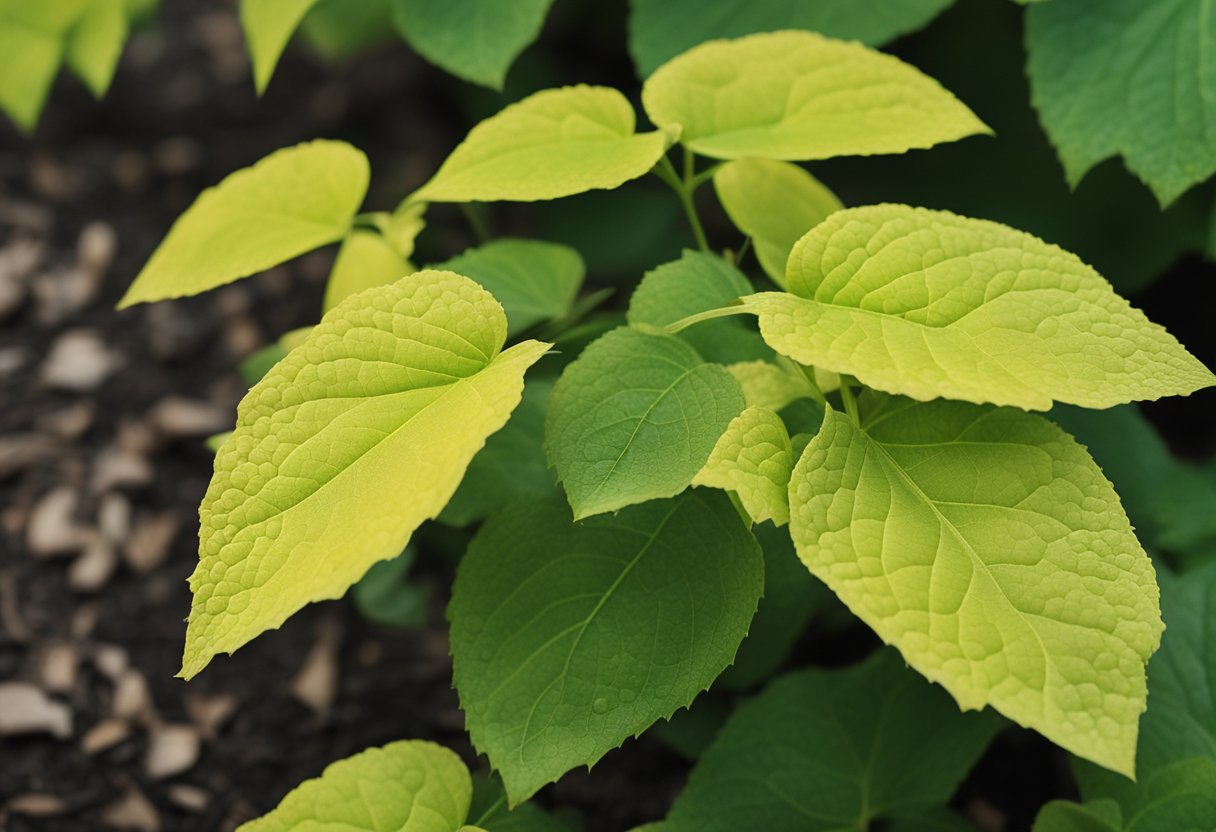
Hydrangeas are susceptible to various pests and diseases that can cause their leaves to turn yellow. In this section, I will discuss the most common pests and fungal diseases that can affect your hydrangeas.
Common Pests
Hydrangeas can be attacked by a range of pests, including aphids, spider mites, and scale insects. These pests feed on the leaves and sap of the plant, causing damage and yellowing of the leaves.
To prevent pest infestations, it is important to keep your hydrangeas healthy and well-maintained. Regularly pruning and removing dead or diseased branches can help to prevent pests from taking hold.
In addition, you can use insecticidal soap or neem oil to control pests. These natural remedies are effective at killing pests without harming the plant or the environment.
Fungal Diseases
Fungal diseases are a common cause of yellowing leaves in hydrangeas. The most common fungal diseases that affect hydrangeas are powdery mildew and leaf spot.
Powdery mildew is a white, powdery coating that appears on the leaves of the plant. It is caused by high humidity and poor air circulation. To prevent powdery mildew, make sure to plant your hydrangeas in a location with good air circulation and avoid overwatering.
Leaf spot is a fungal disease that causes brown spots to appear on the leaves of the plant. It is caused by high humidity and poor air circulation. To prevent leaf spot, make sure to plant your hydrangeas in a location with good air circulation and avoid overwatering.
If your hydrangeas are affected by fungal diseases, you can use fungicides to control the problem. However, it is important to follow the instructions carefully and use the appropriate protective gear to avoid exposure to harmful chemicals.
Proper Hydrangea Maintenance
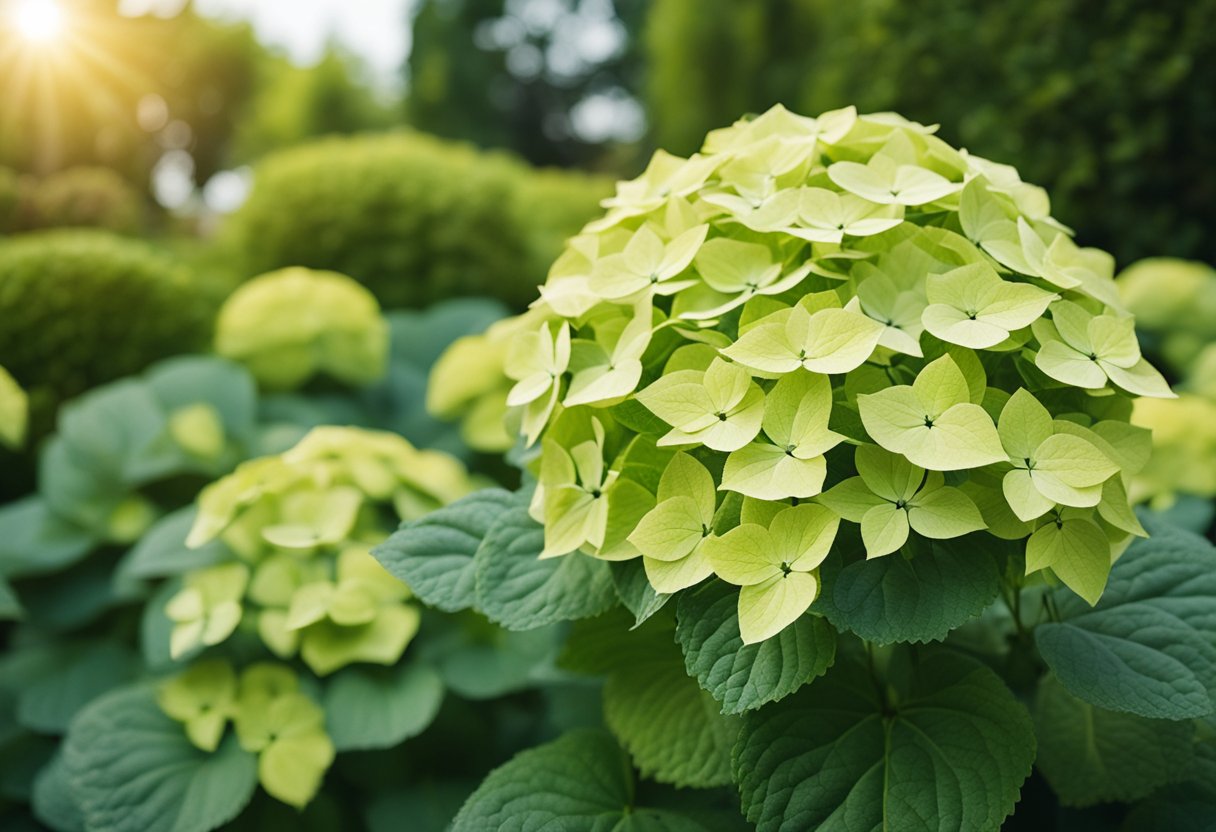
As a gardener, I know that proper maintenance is essential for keeping my hydrangeas healthy and vibrant. Here are some tips for maintaining your hydrangeas and preventing yellow leaves.
Pruning Techniques
Pruning is an important aspect of hydrangea maintenance. Prune your hydrangeas in the late winter or early spring before new growth appears. Cut back dead or damaged wood to healthy growth, and remove any weak or crossing branches. This will help to promote healthy growth and prevent diseases.
Mulching and Weed Control
Mulching is an effective way to keep hydrangeas healthy and reduce weed growth. Apply a layer of organic mulch around the base of the plant, leaving a gap around the stem to prevent rot. This will help to retain moisture in the soil and prevent weed growth.
Weed control is also important for maintaining healthy hydrangeas. Weeds compete with hydrangeas for nutrients and water, which can cause stress and yellowing of the leaves. Hand-pull weeds regularly, or use a hoe or cultivator to remove them. Avoid using chemical weed killers, as they can harm your hydrangeas and the environment.
By following these simple maintenance techniques, you can keep your hydrangeas healthy and prevent yellow leaves.
Choosing the Right Hydrangea Varieties
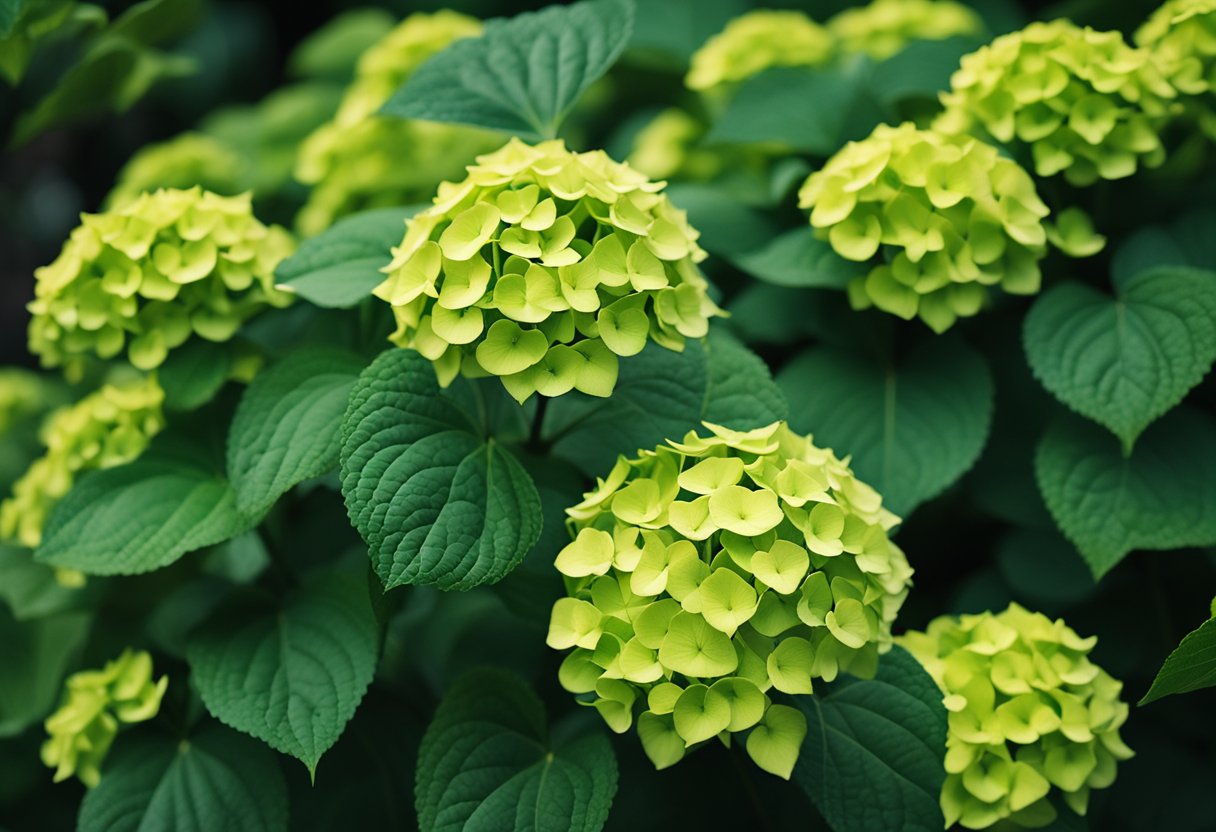
When it comes to choosing the right hydrangea varieties, there are a few things to consider. Hydrangeas come in a variety of species, each with its own unique characteristics. In this section, I will discuss the most popular species and their climatic adaptation.
Hydrangea Species
The most common hydrangea species are the Bigleaf hydrangea (Hydrangea macrophylla), Panicle hydrangea (Hydrangea paniculata), Oakleaf hydrangea (Hydrangea quercifolia), and Smooth hydrangea (Hydrangea arborescens). The Bigleaf hydrangea is the most popular and comes in two types: mophead and lacecap. The mophead has large, round flowers while the lacecap has flat, delicate flowers. The Panicle hydrangea has cone-shaped flowers that change color from white to pink as they mature. The Oakleaf hydrangea has oak-shaped leaves and cone-shaped flowers that turn pink as they mature. The Smooth hydrangea has round flowers that bloom in the summer.
Climatic Adaptation
Hydrangeas are native to Asia and the Americas and have different climatic adaptations. The Bigleaf hydrangea is best suited for USDA zones 6 to 9, while the Panicle hydrangea is adaptable to a wider range of zones, from 3 to 8. The Oakleaf hydrangea is hardy in zones 5 to 9, while the Smooth hydrangea can thrive in zones 3 to 9. It is important to choose a hydrangea species that is adapted to your climate, to ensure that it will thrive in your garden.
When selecting a hydrangea, it is important to consider the species and its climatic adaptation. By choosing the right variety, you can ensure that your hydrangea will thrive in your garden.
Fertilization and Supplements
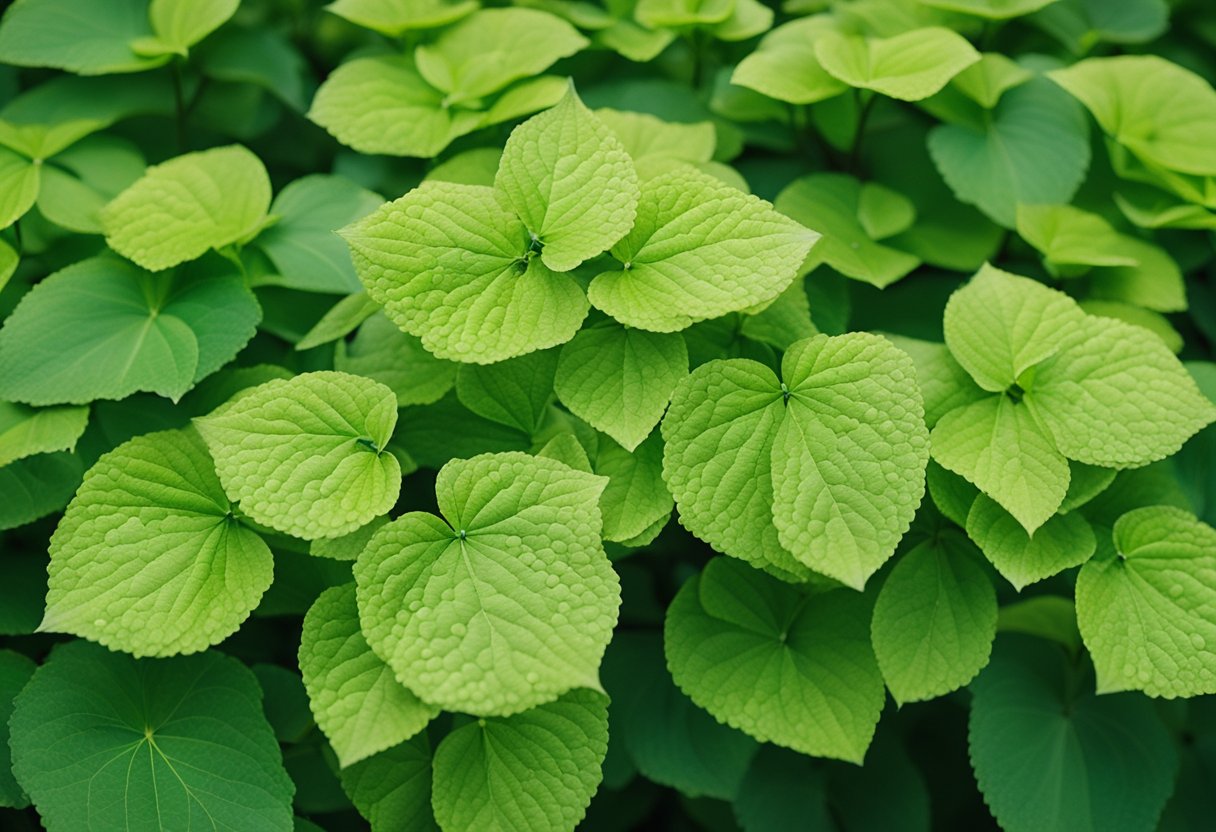
As I mentioned earlier, nutrient deficiencies can cause hydrangea leaves to turn yellow. Therefore, fertilization is an essential aspect of hydrangea care. In this section, I will discuss the types of fertilizers and supplements that can help maintain healthy green leaves on your hydrangeas.
Organic Fertilizers
Organic fertilizers are a popular choice among gardeners because they are natural and environmentally friendly. They are made from organic materials such as compost, manure, and bone meal. These fertilizers release nutrients slowly, providing a steady supply of nutrients to the plant.
One of the best organic fertilizers for hydrangeas is compost. Compost is rich in nutrients and helps improve soil structure and water retention. You can make your own compost by collecting organic materials such as leaves, grass clippings, and kitchen scraps.
Chemical Fertilizers
Chemical fertilizers are another option for hydrangea fertilization. They are made from synthetic materials and provide a quick supply of nutrients to the plant. However, they can be harmful to the environment if not used properly.
When choosing a chemical fertilizer, look for one that is specifically formulated for hydrangeas. These fertilizers contain the right balance of nutrients needed for healthy growth. Follow the instructions carefully when applying chemical fertilizers and avoid over-fertilizing, which can lead to nutrient burn and yellowing of the leaves.
In addition to fertilizers, supplements such as iron and magnesium can also help prevent yellowing of hydrangea leaves. Iron deficiency is a common cause of yellowing leaves in hydrangeas, and adding iron supplements can help correct the problem. Magnesium supplements can also help prevent yellowing caused by magnesium deficiency.
Proper fertilization and supplement use can help maintain healthy green leaves on your hydrangeas.
Seasonal Care and Winterization
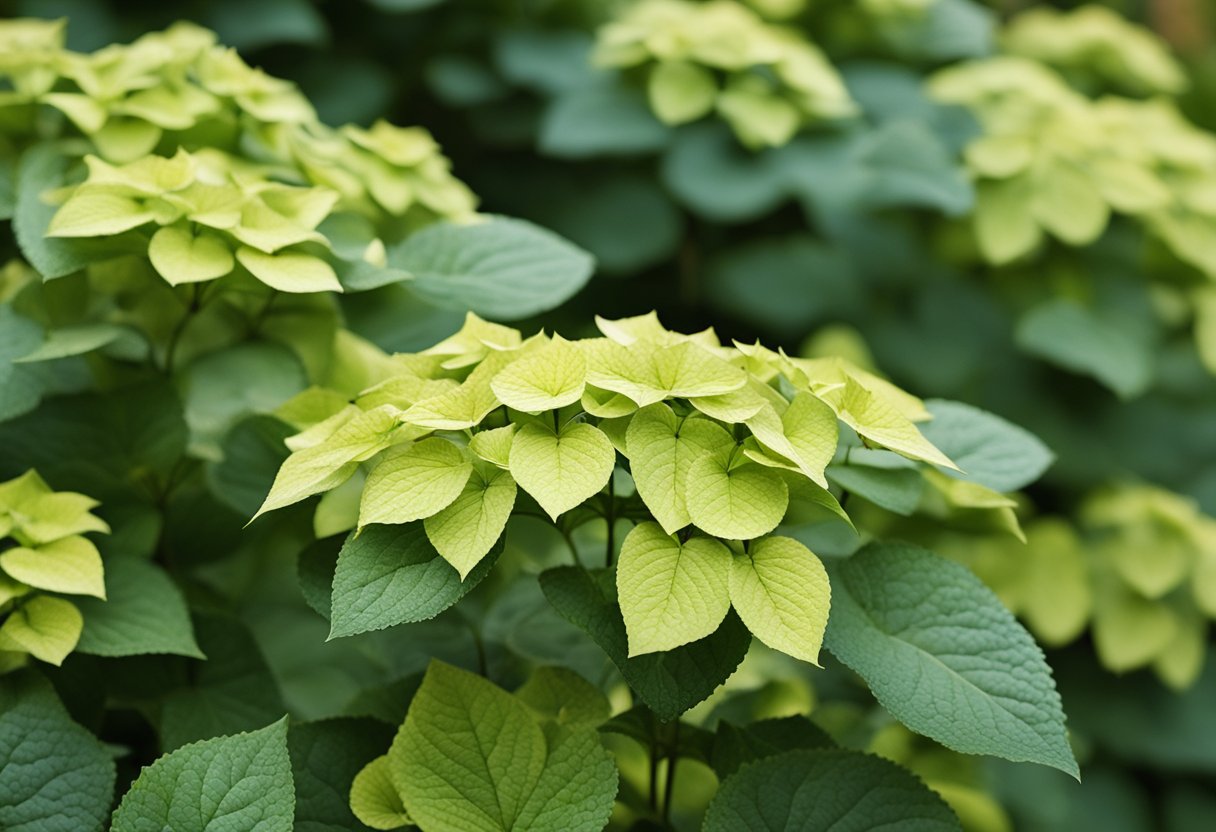
Fall Preparation
As fall approaches, it is important to prepare your hydrangeas for the colder months ahead. One of the main causes of yellowing leaves in hydrangeas is stress from environmental factors such as temperature changes. To help prevent this, avoid fertilizing your hydrangeas in the fall, as this can encourage new growth that may not have time to harden off before winter. Instead, focus on providing your hydrangeas with adequate water and mulch to help insulate the roots and retain moisture.
Another important step in fall preparation is to remove any dead or diseased foliage from the plant. This will not only help prevent the spread of disease but will also improve the overall appearance of the plant. Additionally, if you live in an area with harsh winters, consider wrapping your hydrangeas with burlap or other protective material to shield them from the wind and cold.
Winter Protection
Once winter arrives, it is important to continue providing your hydrangeas with proper care to ensure their survival. One of the most important things to remember is to avoid pruning your hydrangeas in the winter, as this can stimulate new growth that may not survive the cold temperatures. Instead, wait until spring to prune your hydrangeas.
Another important step in winter protection is to provide your hydrangeas with adequate moisture. While you don’t want to overwater your plants, it is important to ensure that the soil around your hydrangeas doesn’t dry out completely. Additionally, consider adding a layer of mulch around the base of your plants to help insulate the roots and retain moisture.
By taking these steps to prepare and protect your hydrangeas in the fall and winter, you can help ensure that they remain healthy and vibrant for years to come.
Reviving Yellowing Hydrangeas
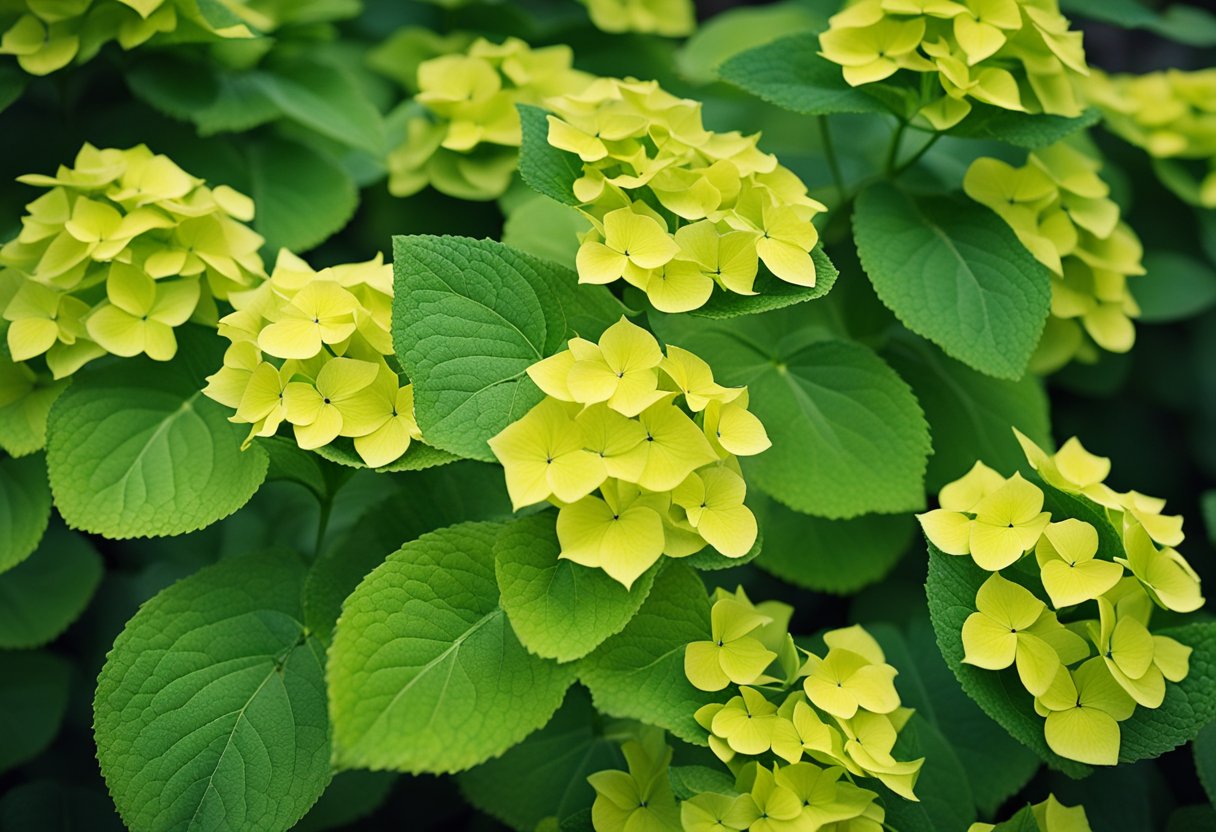
If your hydrangea leaves are turning yellow, there are a few steps you can take to revive them. First, it’s important to identify the cause of the yellowing. Based on the search results, the most common causes of yellowing hydrangea leaves are overwatering, lack of nutrients, and excessive sun exposure.
To address overwatering, make sure the soil around your hydrangea is well-draining and not waterlogged. You can test the soil moisture by poking a finger about 4 inches deep or using a moisture meter. If the soil is overly wet and soggy, withhold water until it dries out. If the foliage continues to turn yellow and wilt, you may need to take more drastic measures.
If your hydrangea is lacking nutrients, you can apply a fertilizer that is specifically formulated for hydrangeas. Look for a fertilizer that is high in phosphorus, which will encourage healthy root growth and help your plant absorb nutrients more effectively.
Excessive sun exposure can also cause hydrangea leaves to turn yellow. If your plant is in direct sunlight for most of the day, consider moving it to a shadier location or providing some shade with a canopy or umbrella.
In addition to these steps, it’s important to maintain good overall plant care. This includes regular pruning, removing dead or damaged leaves, and keeping an eye out for pests or diseases. With proper care and attention, your hydrangeas should be able to recover from yellowing leaves and thrive in your garden.
FAQs – Hydrangea Leaves Turning Yellow
What causes hydrangea leaves to turn yellow?
There are several reasons why hydrangea leaves may turn yellow. One of the most common causes is a lack of nutrients in the soil, particularly nitrogen and iron. Other possible causes include fungal diseases, insect infestations, and improper watering.

How can I treat yellow leaves on my hydrangea plants?
The treatment for yellow leaves on hydrangea plants depends on the underlying cause. If the cause is a lack of nutrients in the soil, you can add fertilizer or compost to provide the necessary nutrients. If the cause is a fungal disease, you may need to use a fungicide to treat the plant. If the cause is improper watering, you may need to adjust your watering routine to ensure that the plant is getting enough water.
What are the signs of an underwatered hydrangea?
An underwatered hydrangea may have wilted leaves that are dry and crispy to the touch. The leaves may also turn yellow or brown and fall off the plant. The stems may become brittle and break easily. If you suspect that your hydrangea is underwatered, you should water it thoroughly and monitor it closely to see if the symptoms improve.
Should yellow or damaged leaves be removed from hydrangeas?
It is generally a good idea to remove yellow or damaged leaves from hydrangeas. This can help to prevent the spread of disease and pests, and it can also improve the overall appearance of the plant. However, you should be careful not to remove too many leaves at once, as this can stress the plant and make it more susceptible to further damage.
How do nutrient deficiencies affect hydrangea leaf color?
Nutrient deficiencies can cause hydrangea leaves to turn yellow or develop other discolorations. For example, a lack of nitrogen can cause yellowing between the veins of the leaves, while a lack of iron can cause the entire leaf to turn yellow. Other nutrient deficiencies can cause leaves to turn brown or develop spots. It is important to identify the specific nutrient deficiency in order to provide the appropriate treatment.
What should I look for to diagnose hydrangea leaf problems?
When diagnosing hydrangea leaf problems, it is important to look for any discolorations, spots, or deformities on the leaves. You should also examine the stems and roots for any signs of damage or disease. It can be helpful to take a sample of the affected plant to a local nursery or garden center for diagnosis and treatment recommendations.
2 thoughts on “Hydrangea Leaves Turning Yellow: Causes and Solutions”